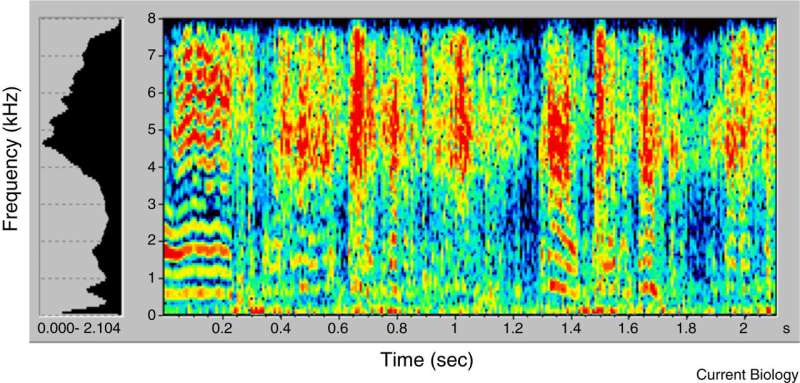August 25, 2023 report
This article has been reviewed according to Science X's editorial process and policies. Editors have highlighted the following attributes while ensuring the content's credibility:
fact-checked
peer-reviewed publication
trusted source
proofread
Hacking animal communication with AI

Ever wonder what birds are talking about? Does eavesdropping on bees sound intriguing? Want to know what your cat really thinks of you?
Researchers Yossi Yovel and Oded Rechavi from the School of Zoology, Wise Faculty of Life Sciences & Sagol School of Neuroscience, Tel Aviv University, Israel, have looked into what it would take for AI to understand non-human animal communication.
In an essay, "AI and the Doctor Dolittle challenge," published in Current Biology, the team probes the nuances of animal intelligence, communication and the potential and limitations of AI capabilities.
The researchers frame communicating with animals as "The Doctor Dolittle challenge" after a popular children's book series with multiple film and animation adaptations. In the fictional story, Doctor Dolittle is taught to understand bird language by a West African parrot named Polynesia, who is conveniently bilingual, speaking both bird and the human language of English.
In the story, Polynesia suggests that animals are just speaking a different language, stating:
"If I say, 'Polly wants a cracker,' you understand me. But hear this: Ka-ka oi-ee, fee-fee?"
"Good Gracious!" cried the Doctor. "What does that mean?"
"That means, 'Is the porridge hot yet?'—in bird-language."
The researchers suggest that regardless of the capabilities of animals, humans or AI, the text and context of communication will be far different than assigning direct meaning to sounds as we might with another human language. Multiple communication factors will be required to converse with the animal world, and the researchers identify three main obstacles.
Context
The first limit is the challenge of distinguishing the context of animal communication. Humans have been recording and mimicking animal communications for decades, and researchers without the aid of AI have been able to elicit responses from various animals based on this technique.
For instance, a female-like robotic frog attracted real male frogs for mating attempts, and a fish robot interacted with live fish during schooling behavior, affecting their movement.
A robotic bee was able to recruit real bees to follow its "waggle dance" instructions and fly to a specific location in a field. The "waggle dance" is how bees usually convey information about the location of food to each other, akin to giving directions with only hand gestures.
These examples demonstrate the potential for engineered stimuli to elicit responses and even communicate information to animals in situations with a specific context. While AI can generate animal-like communication sounds, it is more difficult to determine if they approach any context beyond merely sounding familiar or animal-like.
AI might generate a song of a specific bird after training on recordings, but determining whether the bird is singing to establish territory, attract a mate, or make a vocalization that conveys something else entirely requires additional information.
The authors point out that the same will be valid for non-vocal communication in cases where insects communicate using chemical signals. Deciphering whether the chemical is a signal for mating or a warning about danger versus a random chemical emission can be difficult without observing the insects' behavior.
AI currently requires human input and definitions to begin working on animal communication, such as field recordings of bird songs. Human biases strongly influence the interpretation of these signals because, at some point, the bird song needs to be assigned a context for the AI to make relevant connections to other bird songs. This will require a very controlled approach to observing animal communications that only elicit natural responses.
Eliciting a natural response
Animals exhibit a wide range of behaviors, and their responses can be influenced by numerous factors, including their current physiological state, social dynamics, and environmental conditions.
Different animal species rely on different sensory modalities for communication, such as sound, chemical signals, or body language. Isolating specific responses related to communication might require an array of observational techniques. Experiments cannot train the animals to produce responses, a common research technique, as this closes the window into natural communication and makes the observations lab training dependent.
Measuring responses can also be challenging, as there may be no clear external, measurable response. Humans may be more prone to miss subtle responses. AI algorithms trained to interpret responses will be at greater risk of taking subtle gestures as a response and finding correlations where none actually exist.
Limited range of contexts
The third obstacle identified involves animal communication focusing on a restricted set of contexts, such as alarm and courtship. This limitation reduces the ability to communicate with animals about a wide range of topics or contexts, potentially limiting the scope of inter-species communication. At least, it may not rise to the level of expectation if a successful AI translator is built only to reveal that the birds are communicating the equivalent of sad face and eggplant emojis all day.
Potential benefits
There are potential benefits of communicating with animals. Communicating efficiently with honeybees or other pollinators could benefit farming. Distinguishing the mood or disposition of farm animals might aid in their care. Understanding the chatter in a protected forest might alert conservationists to an unseen threat. Research experiments could significantly improve if mice could share a self-reported perspective.
It also has implications as a first contact rehearsal for potential extraterrestrial encounters. If we cannot communicate with intelligent life on this planet, what hope would we have of ever communicating with life on another?
More information: Yossi Yovel et al, AI and the Doctor Dolittle challenge, Current Biology (2023). DOI: 10.1016/j.cub.2023.06.063
Journal information: Current Biology
© 2023 Science X Network





















